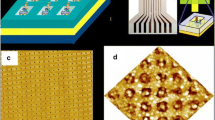Abstract
We report the electrochemical deposition of poly(pyrrolepropylic acid) nanowires, their covalent modification with antibodies and their conversion into potential functional sensor devices. The nanowires and the devices were characterised by optical microscopy, fluorescence microscopy, electron microscopy and electrical measurements. Fluorescence images, current–voltage (I–V) profiles and real-time sensing measurements demonstrated a rapid and highly sensitive and selective detection of human serum albumin (HSA), a substance that has been used to diagnose incipient renal disease. The detection is based on the selective binding of HSA onto anti-HSA that is covalently attached to the nanowires. The binding changes the electrical properties of the nanowires thus enabling the real-time detection. Whilst the utility of the research was demonstrated for protein binding/detection, the technology could easily be designed for the detection of other analytes by the modification of polymer nanowires with other analyte-specific molecules/biomolecules. Therefore, the technology has the potential to positively impact broad analytical applications in the biomedical, environmental and other sectors.

Real-time dynamic current response on sequential exposure of buffer, bovine serum albumin (BSA) and human serum albumin (HSA) onto anti-HSA modified poly (pyrrolepropylic acid) nanowires. Fluorescence images of poly(pyrrolepropylic acid) nanowire (top right) and polypyrrole nanowire control (bottom right) after sequential treatment with 1-ethyl-3-(3-dimethylaminopropyl) carbodiimide hydrochloride (EDC), anti HSA and fluorophore-labeled HSA.







Similar content being viewed by others
References
Besteman K, Lee JO, Wiertz FGM, Heering HA, Dekker C (2003) Nano Lett 3:727–730
Star A, Gabriel JCP, Bradley K, Gruner G (2003) Nano Lett 3:459–463
Drouvalakis KA, Bangsaruntip S, Hueber W, Kozar LG, Utz PJ, Dai HJ (2008) Biosens Bioelectron 23:1413–1421
Zheng GF, Patolsky F, Cui Y, Wang WU, Lieber CM (2005) Nat Biotechnol 23:1294–1301
Patolsky F, Zheng GF, Hayden O, Lakadamyali M, Zhuang XW, Lieber CM (2004) Proc Natl Acad Sci U S A 101:14017–14022
Cui Y, Wei QQ, Park HK, Lieber CM (2001) Science 293:1289–1292
Hahm J, Lieber CM (2004) Nano Lett 4:51–54
Aravinda CL, Cosnier S, Chen W, Myung NV, Mulchandani A (2008) Biosens Bioelectron doi:10.1016/j.bios.2008.08.044 (in press)
Jerome C, Jerome R (1998) Angew Chem Int Ed 37:2488–2490
Martin CR (1994) Science 266:1961–1966
Cosnier S (2005) Electroanalysis 17:1701–1715
Beh WS, Kim IT, Qin D, Xia YN, Whitesides GM (1999) Adv Mater 11:1038–1041
Persson SHM, Dyreklev P, Inganas O (1996) Adv Mater 8:405–&
Lipomi DJ, Chiechi RC, Dickey MD, Whitesides GM (2008) Nano Lett 8:2100–2105
Huang ZY, Wang PC, MacDiarmid AG, Xia YN, Whitesides G (1997) Langmuir 13:6480–6484
Kranz C, Ludwig M, Gaub HE, Schuhmann W (1995) Adv Mater 7:38–40
Rogers JA, Bao Z, Baldwin K, Dodabalapur A, Crone B, Raju VR, Kuck V, Katz H, Amundson K, Ewing J, Drzaic P (2001) Proc Natl Acad Sci U S A 98:4835–4840
Lim JH, Mirkin CA (2002) Adv Mater 14:1474–1477
He HX, Li CZ, Tao NJ (2001) Applied Physics Letters 78:811–813
Doshi J, Reneker DH (1995) J Electrost 35:151–160
Reneker DH, Yarin AL, Fong H, Koombhongse S (2000) J Appl Physi 87:4531–4547
Ramanathan K, Bangar MA, Yun MH, Chen W, Mulchandani A, Myung NV (2004) Nano Letters 4:1237–1239
Brynda E, Houska M, Brandenburg A, Wikerstal A (2002) Biosens Bioelectron 17:665–675
Saber R, Mutlu S, Piskin E (2002) Biosens Bioelectron 17:727–734
Sadik OA, Cheung MC (2001) Talanta 55:929–941
Dong H, Li CM, Chen W, Zhou Q, Zeng ZX, Luong JHT (2006) Anal Chem 78:7424–7431
Ko JM, Rhee HW, Park SM, Kim CY (1990) J Electrochem Soc 137:905–909
Hernandez RM, Richter L, Semancik S, Stranick S, Mallouk TE (2004) Chem Mater 16:3431–3438
Ramanathan K, Bangar MA, Yun M, Chen W, Myung NV, Mulchandani A (2005) J Am Chem Soc 127:496–497
Wanekaya AK, Chen W, Myung NV, Mulchandani A (2006) Electroanalysis 18:533–550
Chen RJ, Bangsaruntip S, Drouvalakis KA, Kam NWS, Shim M, Li YM, Kim W, Utz PJ, Dai HJ (2003) Proc Natl Acad Sci U S A 100:4984–4989
Acknowledgements
We greatly acknowledge support by the Missouri State University Faculty Summer Fellowship.
Author information
Authors and Affiliations
Corresponding author
Rights and permissions
About this article
Cite this article
Tolani, S.B., Craig, M., DeLong, R.K. et al. Towards biosensors based on conducting polymer nanowires. Anal Bioanal Chem 393, 1225–1231 (2009). https://doi.org/10.1007/s00216-008-2556-0
Received:
Revised:
Accepted:
Published:
Issue Date:
DOI: https://doi.org/10.1007/s00216-008-2556-0




